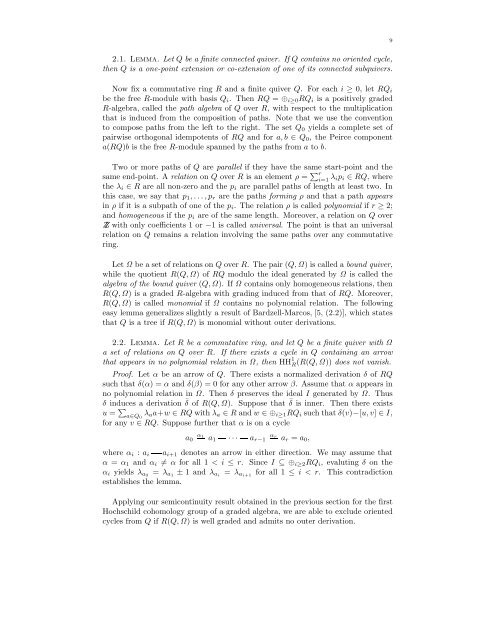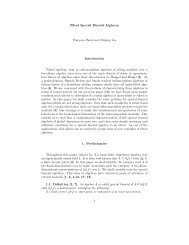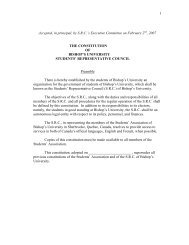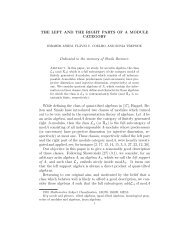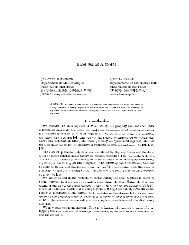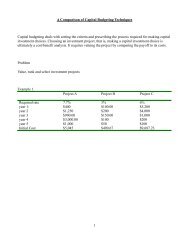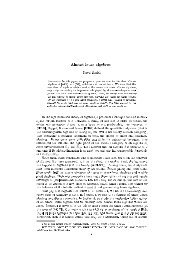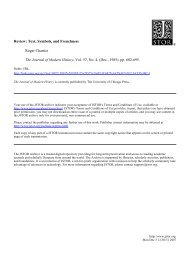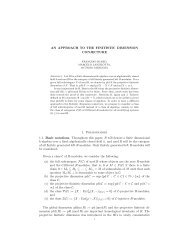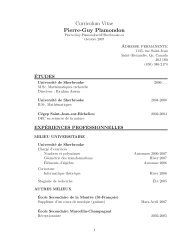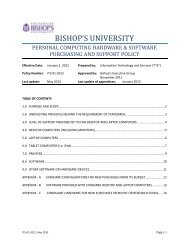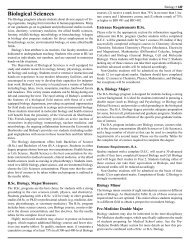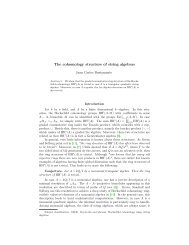Hochschild Cohomology and Representation-finite Algebras Ragnar ...
Hochschild Cohomology and Representation-finite Algebras Ragnar ...
Hochschild Cohomology and Representation-finite Algebras Ragnar ...
You also want an ePaper? Increase the reach of your titles
YUMPU automatically turns print PDFs into web optimized ePapers that Google loves.
9<br />
2.1. Lemma. Let Q be a <strong>finite</strong> connected quiver. If Q contains no oriented cycle,<br />
then Q is a one-point extension or co-extension of one of its connected subquivers.<br />
Now fix a commutative ring R <strong>and</strong> a <strong>finite</strong> quiver Q. For each i ≥ 0, let RQ i<br />
be the free R-module with basis Q i . Then RQ = ⊕ i≥0 RQ i is a positively graded<br />
R-algebra, called the path algebra of Q over R, with respect to the multiplication<br />
that is induced from the composition of paths. Note that we use the convention<br />
to compose paths from the left to the right. The set Q 0 yields a complete set of<br />
pairwise orthogonal idempotents of RQ <strong>and</strong> for a, b ∈ Q 0 , the Peirce component<br />
a(RQ)b is the free R-module spanned by the paths from a to b.<br />
Two or more paths of Q are parallel if they have the same start-point <strong>and</strong> the<br />
same end-point. A relation on Q over R is an element ρ = ∑ r<br />
i=1 λ ip i ∈ RQ, where<br />
the λ i ∈ R are all non-zero <strong>and</strong> the p i are parallel paths of length at least two. In<br />
this case, we say that p 1 ,...,p r are the paths forming ρ <strong>and</strong> that a path appears<br />
in ρ if it is a subpath of one of the p i .Therelationρ is called polynomial if r ≥ 2;<br />
<strong>and</strong> homogeneous if the p i are of the same length. Moreover, a relation on Q over<br />
Z with only coefficients 1 or −1 is called universal. The point is that an universal<br />
relation on Q remains a relation involving the same paths over any commutative<br />
ring.<br />
Let Ω be a set of relations on Q over R. The pair (Q, Ω) is called a bound quiver,<br />
while the quotient R(Q, Ω) ofRQ modulo the ideal generated by Ω is called the<br />
algebra of the bound quiver (Q, Ω). If Ω contains only homogeneous relations, then<br />
R(Q, Ω) is a graded R-algebra with grading induced from that of RQ. Moreover,<br />
R(Q, Ω) is called monomial if Ω contains no polynomial relation. The following<br />
easy lemma generalizes slightly a result of Bardzell-Marcos, [5, (2.2)], which states<br />
that Q is a tree if R(Q, Ω) is monomial without outer derivations.<br />
2.2. Lemma. Let R be a commutative ring, <strong>and</strong> let Q be a <strong>finite</strong> quiver with Ω<br />
a set of relations on Q over R. If there exists a cycle in Q containing an arrow<br />
that appears in no polynomial relation in Ω, then HH 1 R (R(Q, Ω)) does not vanish.<br />
Proof. Let α be an arrow of Q. There exists a normalized derivation δ of RQ<br />
such that δ(α) =α <strong>and</strong> δ(β) = 0 for any other arrow β. Assume that α appears in<br />
no polynomial relation in Ω. Then δ preserves the ideal I generated by Ω. Thus<br />
δ induces a derivation ¯δ of R(Q, Ω). Suppose that ¯δ is inner. Then there exists<br />
u = ∑ a∈Q 0<br />
λ a a+w ∈ RQ with λ a ∈ R <strong>and</strong> w ∈⊕ i≥1 RQ i such that δ(v)−[u, v] ∈ I,<br />
for any v ∈ RQ. Suppose further that α is on a cycle<br />
a 0<br />
α 1<br />
a 1 ··· a r−1<br />
α r<br />
a r = a 0 ,<br />
where α i : a i a i+1 denotes an arrow in either direction. We may assume that<br />
α = α 1 <strong>and</strong> α i ≠ α for all 1


